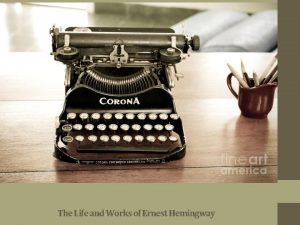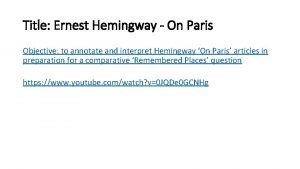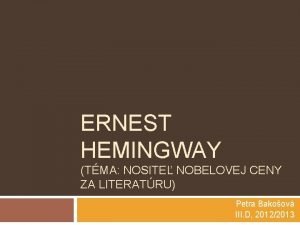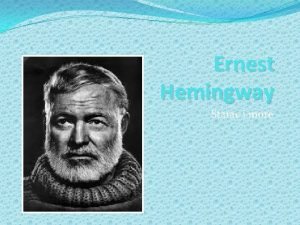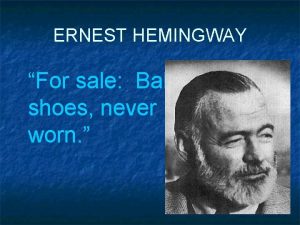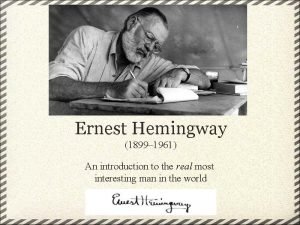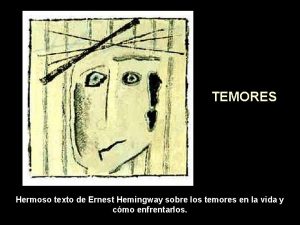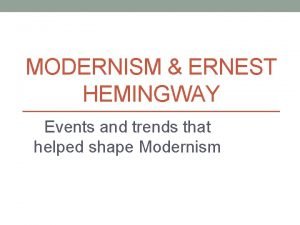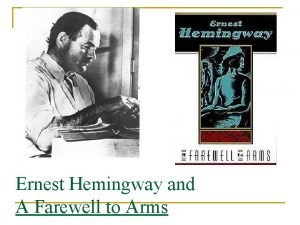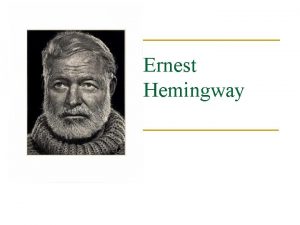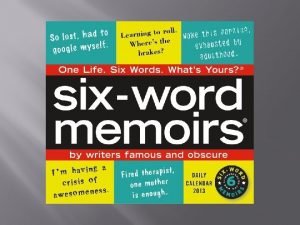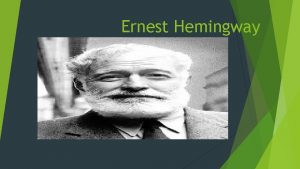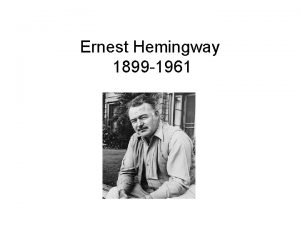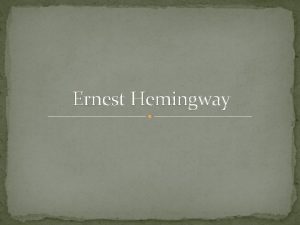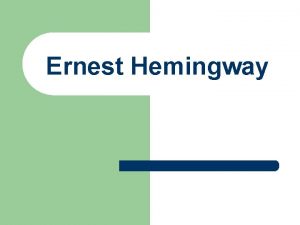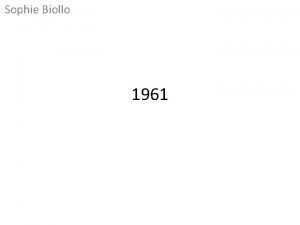The Life and Works of Ernest Hemingway Ernest











- Slides: 11

The Life and Works of Ernest Hemingway

Ernest Hemingway And His Works

About Ernest Hemingway * He was born in Oak Park, Illinois on July 21, 1899. * He wrote on his High School Paper. * Became a Journalist after High School. *Was in World War I and received the Silver Metal of Military Valor. * Was a Journalist in the Spanish Civil War and in World War II. * He married four times and had three children. * When he wasn't writing, Hemingway spent much of his time chasing adventure such as big-game hunting in Africa, bullfighting in Spain and deep-sea fishing in Florida. * He suffered from depression and alcoholism * He committed suicide July 2 nd, 1961.

Writing Style • * Ernest Hemingway was one of the twentieth century most important and influential writers. • * Numerous influences from various people and events from his personal life had a strong effect on his writing. He drew heavily on his these experiences for his writing. • * Ernest Hemingway’s writing is among the most recognizable and influential prose of the twentieth century. • * Hemingway’s technique is uncomplicated with plain grammar and easily accessible language. It is a simple style and straight forward. • * Hemingway's writing style abstains from using adjectives as much as possible and is considered a master of dialogue. The words that he uses in his stories is a unique formula, a stylistic formula that no other writer has been able to recreate.

Hemingway’s Theory of Omission Ernest Hemingway “If a writer of prose knows enough about what he is writing about he may omit things that he knows and the reader, if the writer is writing truly enough, will have a feeling of those things as strongly as though the writer had stated them. The dignity of movement of an iceberg is due to only one-eighth of it being above water. ” Ernest Hemingway Ice burg Principle • Ernest Hemingway's theory of omission is widely referred to as the "iceberg principle. " He explains this principle in chapter 16 of his 1932 book, Death in the Afternoon. Essentially, the principle states that by omitting certain parts of a story, a writer actually strengthens that story. The writer must be conscious of these omissions and be writing true enough in order for the reader to sense the omitted parts. When the reader senses the omitted parts, a greater perception and understanding for the story can be achieved.

Inspiration • Ernest Hemingway learned a great deal as a cub reporter for the Kansas City Star. Throughout his lifetime he used the guidance of the Star's style guide as a foundation for his writing style: "Use short sentences. Use short first paragraphs. Use vigorous English.

He won the Nobel Prize in literature in 1954 Novels short stories and non fiction written by Ernest Hemingway • The Torrents of Spring (1925) • The Sun Also Rises (1926) • A Farewell to Arms (1929) • To Have and Have Not(1937) • For Whom the Bell Tolls (1940) • Across the River and Into the Trees (1950) • The Old Man and the Sea (1952) • Adventures of a Young Man (1962) • Islands in the Stream (1970) • The Garden of Eden (1986) The novel “The Old Man and the Sea” won the Nobel prize.

Short Stories and Non fiction • Short Story Collections • Three Stories and Ten Poems (1923) • In Our Time (1925) • Men Without Women (1927) • The Snows of Kilimanjaro (1932) • Winner Take Nothing (1933) • The Fifth Column and the First Forty-Nine Stories (1938) • The Essential Hemingway (1947) • The Hemingway Reader (1953) • The Nick Adams Stories (1972) Nonfiction Death in the Afternoon (1932) Green Hills of Africa (1935) The Dangerous Summer (1960) • A Moveable Feast (1964) • •

Many of his books dealt with good versus evil • Such as War, hostile tribes or the conflicts of overcoming war. • The author is able to convey a realistic aspect due to his life experiences. He shows how one adapts and overcomes the ugly, evil side of man.

In his own words "From things that have happened and from things as they exist and from all things that you know and all those you cannot know, you make something through your invention that is not a representation but a whole new thing truer than anything true and alive, and you make it alive, and if you make it well enough, you give it immortality. “ Ernest Hemingway

Works Cited Internet sources http: //grammar. about. com/b/2011/08/22/revision-strategieshemingways-iceberg-theory. htm web 03/03/2013 http: //www. hemingwaysociety. org/ http: //ezinearticles. com/? The-Writing-Style-of-Hemingway&id=70613 web 03/03/2013 http: //www. neabigread. org/books/farewelltoarms/teachers/hemingw ay_handout 03. pdf web 03/03/2013 http: //www. biography. com/people/ernest-hemingway-9334498 web 03/03/2013 http: //sunalsorises. wordpress. com/2010/06/05/hemingways-icebergtheory/ web 03/03/2013 Books Hemingway, Ernest (2003) [1932]. Death in the Afternoon (1 st Scribner trade pbk. ed. ). New York, New York: Charles Scribner's Sons.
